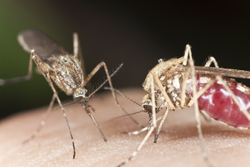Malaria vector control using Wolbachiabacteria
Malaria infects approximately 500 million individuals annually, with over 1 million deaths occurring due to Plasmodium falciparum parasite infections. Anopheles gambiae (A. gambiae) mosquitoes are the major vectors, or carriers, of the parasite in Africa. One way to reduce transmission of the disease is by controlling the insect vector. Although several control programmes have been successful in the past, many have been compromised because of insecticide resistance. There is thus still a great need to investigate and develop novel malaria control strategies. The project 'Population age structure and age structure modification via Wolbachia in Anopheles gambiae' (ANOPOPAGE) looked at one such approach. Researchers successfully infected A. gambiae cell lines with various Wolbachia strains. They investigated the effect these Wolbachia strains have on immunity in the mosquitoes, and found that there was an increased expression of malaria-related immunity genes. The non-virulent line wAu was the most successful strain. Estimating the population age distribution of female mosquitoes in the field is a critical, yet poorly characterised, component of vectorial capacity. This is due to the lengthy incubation period of mosquito-borne pathogens. The ANOPOPAGE researchers examined global gene expression over adult life in nine genes with age-related transcription patterns. The method allowed for an accurate prediction of mean female age in lab-reared samples, and a slightly lower accuracy in wild-caught specimens. A mathematical model, produced using mosquito demography and population dynamics, allowed for an assessment of the best strategy for the release of Wolbachia-infected A. gambiae into the wild. Researchers considered repeated small male-biased releases to be most effective. Future investigations could focus on other Plasmodium-inhibiting bacteria that can be introduced into Anopheles mosquitoes more easily. The tools and models developed here thus provide a significant advance for the study of malaria epidemiology in Africa.







